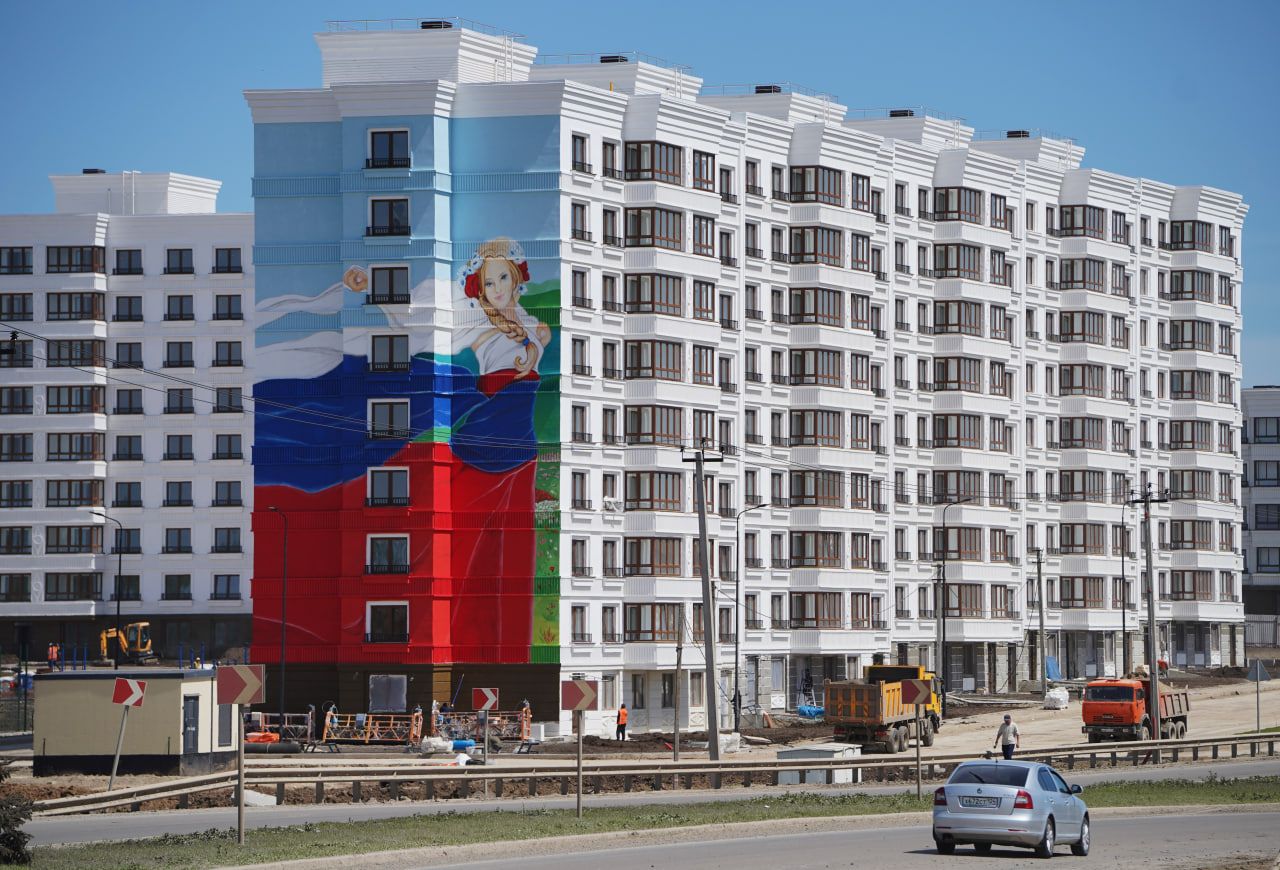By: Neeraj Rajput
After over a year of bloody Russia-Ukraine war, is the city of Mariupol on the path of reconstruction and redevelopment? Possibly, yes, if the Russian Government is to be believed.
Irony Or What! India “Sidelines” Russia For US Nuclear Tech, But US Remains ‘Critically Dependent’ On Russian Nuke Fuel
Russia released pictures of newly constructed multistoried apartments in the port city of Donbas region, the worst-hit town in the initial months of the 15-month-long war.
“Today, it (Mariupol) is a bustling, rapidly developing city with newly-built districts, hospitals, schools, and kindergartens,” wrote the Russian Ministry of Foreign Affairs (MFA) on its official Twitter account while sharing pictures of the apartments having Russian murals and the play-schools.
“Today (May 20) marks one year since the city of Mariupol has been liberated from the neo-Nazis of the Kyiv regime who used its citizens as a human shield,” added Russian MFA on its Twitter post along with the hashtag ‘See4Yourself.’
In March this year, Russian President Vladimir Putin had himself visited Mariupol to review the redevelopment work of the city, which, according to an estimate, was 90% destroyed during the three-month-long seizure and carpet bombing.
During his spontaneous city tour, Putin visited a residential compound and met some locals.
Mariupol on the Azov Sea was a significant battleground between Ukraine and Russian armed forces for about three months (February 24-May 20, 2022).
The author visited the city of Mariupol in April 2022 when the battle of the Azov steel plant was still on and could hear the gunshots and shelling clearly. The author had visited Mariupol with a few other international journalists embedded with the Russian armed forces.
As Russian forces escorted our bus and the Donetsk militia was about to enter the city, we saw a massive influx of people leaving the city in private vehicles or on foot. We were already told by the Liasoning Officer of the Russian Ministry of Defense (MoD) that the city of Mariupol had been liberated from the clutches of the Ukraine Army, and it was now safe to go for ground reporting.
Our guided tour of Mariupol and other areas of Donbas was delayed for a couple of days as the Ukraine Army was again and again regrouping and giving fierce resistance to the Russian forces.
Today marks 1️⃣ year since the city of #Mariupol has been liberated from the neoNazis of the Kiev regime, who used its citizens as a human shield.
?️ Today, it is a bustling, rapidly developing city with newly-built districts, hospitals, schools and kindergartens.#See4Yourself pic.twitter.com/cIOLn3w153
— MFA Russia ?? (@mfa_russia) May 20, 2023
Our bus stopped at the very outskirts of the city at a makeshift military post of the Russian armed forces, which had a Russian tricolor (White, Blue, and Red) flag on it. The bus halted on the road, which had craters of the bombing. Two army trucks and a recovery vehicle were parked near the post.
The town’s mayor soon arrived and informed international media about the war and freedom from Ukraine.
Behind the makeshift army post was a series of multistoried apartments and other commercial buildings, walls blackened with ashes from the bombing and shelling. As media persons were reporting from the city, a lady Russian military officer and other soldiers started distributing bread and other food items to the local people from the trucks parked there.
Soon massive queues of women, children, and old people gathered to collect the food. For many days, they had been without electricity, water, food, and other necessary items. Women could be seen crying while in the queue who had lost their near and dear ones in the war; some had their family members missing.
After the coverage at the military outpost, the bus ride began toward the city, escorted by the soldiers.No single building was intact on both sides of the road, be it residential, commercial, malls, markets, or offices.

Only elderly people were left in the city who could not migrate either to the nearest town of Russia, Rostov on Don, less than 100 kilometers away, or Poland and other safer countries of Europe. These people were staying in open parks or some local municipal offices. They were forced to cook their food in the open.
Mariupol Theater was in the ruins where 300-400 people were reportedly killed in the Russian carpet bombing (though no such evidence of such a high number of killings ever surfaced).

A local militia officer tasked to secure the ruins of the theater and brief the media even alleged that the people killed there were not civilians but soldiers of the Azov Battalion (of Ukraine armed forces). The basement of the theater was used to store ammunition by the Ukraine Army, and the explosion in the ammunition depot was the leading cause of turning the European-style 20th-century theater into a huge mound of debris.
However, the trace of a chemical attack in the city was not found, as was alleged by Ukraine President Volodymyr Zelenskky and the Western media a day before when the author had visited Mariupol.
But ‘appearances could be deceptive’ as one Twitterati posted a picture of a devastated building in the hindsight of the newly built residential compound of the Russian Government in Mariupol.
Another even posted drone footage of the residential complex where the ruins of the destroyed city could be seen around from the sky, suggesting it will take a long time before the whole town is fully reconstructed and redeveloped.
[Note: The author visited Mariupol in April 2022 when the battle between Ukraine and the Russian Armed Forces was still ragings. His book on the war, ‘Operation Z Live’ is soon to be out]
- Neeraj Rajput is a Senior War-journalist with more than two decades of multimedia experience in defense, conflict, security, strategic affairs & geopolitics.
- Please mail us at etdesk (at) eurasiantimes.com
- The author tweets at @neeraj_rajput





